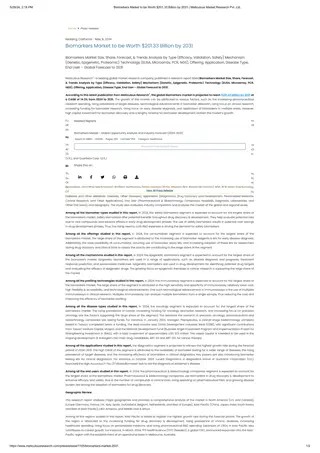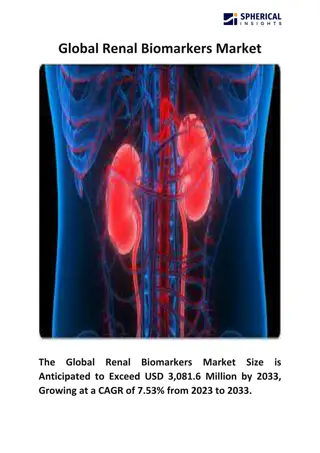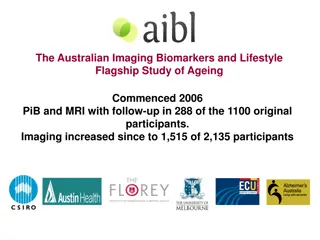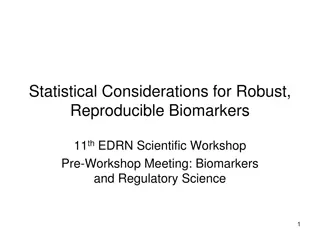
Understanding Biomarkers in Disease Diagnosis and Treatment
Explore the significance of biomarkers in diagnosing and treating various diseases, including heart, cancer, liver, kidney, and pancreatic conditions. Learn about different types of biomarkers and their role in disease management, prognosis, and follow-up. Differentiate between serum and plasma as common body fluid samples for biomarker measurement and understand the implications of tissue-specific and plasma-specific biomarkers in diagnosing organ damage.
Download Presentation

Please find below an Image/Link to download the presentation.
The content on the website is provided AS IS for your information and personal use only. It may not be sold, licensed, or shared on other websites without obtaining consent from the author. If you encounter any issues during the download, it is possible that the publisher has removed the file from their server.
You are allowed to download the files provided on this website for personal or commercial use, subject to the condition that they are used lawfully. All files are the property of their respective owners.
The content on the website is provided AS IS for your information and personal use only. It may not be sold, licensed, or shared on other websites without obtaining consent from the author.
E N D
Presentation Transcript
Biochemical markers Color Index: Important. 436 Biochemistry team Extra Information. Doctors slides.
Objectives : Comprehend the importance & diagnostic qualities of various biomarkers . Understand the importance of different biomarkers in the diagnosis, treatment, & follow up of a disease . Recognize the types of biomarkers & their use in specific diseases such as heart, cancer, liver, kidney, & pancreatic diseases .
What is biomarkers? A biological molecule found in blood ,and other body fluids, or tissues that indicates a normal or abnormal process such as a disease or a condition . A biomarker is measured to follow up a disease or treatment . Diagnosis & Prognosis Diagnosis: Identification of a disease from its signs and symptoms . Prognosis: The future outcome of a disease . . *
Most common body fluids (Samples) for measurement of biomarkers are : What is the difference between Serum and Plasma ? They are the same , but plasma has coagulation factors and serum has no coagulation factors. 1. Serum 2. Plasma 3. Urine Biomarkers can be either : Plasma specific Tissue specific 436 Biochemistry team
Tissue-specific biomarkers:* Plasma-specific Biomarkers: Normally present in Plasma . Present inside the cell . (can be present in tissues in low amount or totally absent ). Perform their functions in blood. High level of activity in plasma than in tissue cells . Examples : Blood clotting enzymes (thrombin), cholinesterase, etc. A low concentration can be detected in plasma due to cellular turnover. Released into body fluids in high conc. Due to : Cell damage*. 1. Defective cell membrane. 2. *Cell damage can be due to: 1- Tissue inflammation, example: -ALT* in liver disease (e.g. acute hepatitis) -Amylase in acute pancreatitis 2- Ischemia hypoxia infarction plasma [Troponin] in myocardial Infarction When Tissue-specific biomarkers are released to body fluids , it will help us diagnose which part of the body has the problem (for example: if the patient has a heart attack or kidney failure) ALT*: alanine aminotransferase
Intracellular enzymes are present only in their cells of origin Some are secretory enzymes are secreted by: salivary glands, gastric mucosa and pancreas In disease: plasma levels of secretory enzymes increase when their cells are damaged The diagnosis of organ disease is done by measurement of enzymes of that tissue ) (
Cell damage Factors affecting serum Rate of biomarker synthesis and clearance biomarker levels Enzyme inhibitors Glucose deficiency Localized Hypoxia (less oxygen) Ischemia (obstruction of blood vessels) Necrosis Tissue infarction due to ischemic necrosis Myocardial infarction
#Qualities of a good biomarker: Able to accurately predict prognosis of a disease Able to accurately diagnose a disease Compliant* with treatment follow up Easily obtainable from blood, urine, etc *This means it changes after treatment which allows us to evaluate the progress (weather the treatment working or not) and predict prognosis #Qualities (Criteria) of a good biomarker assay: *Assay means a test, So a biomarker assay is a test that measures a biomarker Sensitive: able to detect small quantities of a marker Specific: Able to detect only the marker of interest Rapid *Robust* to deliver results faster
Enzymes Enzymes as biomarkers Types of biomarkers Enzymes are clinically used for the diagnosis and prognosis of various diseases Hormones Proteins Proteins include Enzymes include Hormones include Cystatin C Amylase BNP* Lipase AMH PSA** Alanine aminotransferase ( ALT) -Fetoprotein*** Aspartate aminotransferase (AST) *** -Fetoprotein is also (tumor marker) **Prostate Specific Antigen (PSA) (tumor marker) *B-type natriuretic peptide (BNP)
Enzymes: Amylase and Lipase Cause of pancreatitis Acute pancreatitis: the inflammation of pancreas There is abnormal release and premature activation of pancreatic enzymes (for example amylase, lipase) Diagnosis conducted by measuring pancreatic enzymes Obstruction of the pancreatic duct Gallstones Alcohol abuse During pancreatitis Amylase Lipase Level in plasma compared to normal 10 times 2 times 2-12 hour after abdominal pain (onset symptom) and returns to normal in 2-3 days Required time to appear in serum 4-8 hours and remain for 8-14 days Specificity low high Measurement of amylase and lipase give 90-95% accuracy in the diagnosis of acute pancreatitis and abdominal pain. Amylase test has low specificity because elevated serum amylase level is present in other diseases. Lipase elevated ONLY in Acute pancreatitis. Free amylase (unbound form) is rapidly cleared by the kidneys. Gallstones are a common cause of pancreatitis. Gallstones, produced in the gallbladder, can block the bile duct, stopping pancreatic enzymes from traveling to the small intestine and forcing them back into the pancreas. The enzymes then begin to irritate the cells of the pancreas, causing the inflammation associated with pancreatitis.
Enzymes: ALT and AST ALT (Alanine amino-transferase) and AST (Aspartate amino-transferase) are tissue-specific biomarkers. Which means they are normally found in the serum in LOW levels, when there is a condition or a disease in the liver (cell damage) or any other tissues have those biomarkers there will be HIGH serum levels of ALT & AST. Markers used in hepatocellular necrosis ALT AST High serum ALT and AST levels in liver diseases are due to: Alcohol abuse Medication Chronic hepatitis B and C Wilson s disease HIGH SPECEFIC LOW SPECEFIC Produced by: Produced by: Heart, liver, skeletal muscle, kidney and small amount in RBC *erythrocytes*. Mostly in liver, small amounts in heart. accumulation of copper in the liver. Autoimmune hepatitis Steatosis and steatohepatitis Major diagnosis *elevated in*: (High serum activity) Major diagnosis *elevated in*: Steatosis is Fatty liver a condition in which Fatty acid accumulates in the liver liver, skeletal muscle, heart diseases and hemolysis. liver diseases. 1-antitrypsin deficiency Proteaseinhibitor Malignancy Poisons and infectious agents Hemolysis means the RBC s lysis. As AST can be found in small amounts in RBC S that means when RBC S are lysed AST will be found in the serum
Proteins as biomarkers B-type natriuretic** peptide (BNP) Prostate Specific Antigen (PSA) (Tumor marker) -Fetoprotein: (Tumor marker) Cystatin C A cysteine protease inhibitor mainly produced by all nucleated cells of the body. Useful biomarker for measuring glomerular filtration rate(GFR)**** in assessing kidney function. Unlike creatinine, its serum conc. is independent of gender,age or muscle mass* High levels of serum cystatin C indicates kidney (renal) failure Clinically used as a marker for: 1- detecting earlykidney disease. 2- monitoring kidney transplantation & acute kidney injury A peptide secreted mainly in the cardiac ventricles in response to cardiac-expansion and pressure overload. High serum levels (abnormal) are observed in congestive heartfailure. ) It can be used to differentiate patients whose symptoms are due to heart failure (very high) from those whose symptoms are due to other causes such as pulmonary disease (slightly high). A serine protease*** enzyme also called kallikrein , seminin. Produced by prostate gland PSA level is used as a tumor marker to aid diagnosis and for monitoring in patients with prostatic cancer. Liquefies ejaculate. Less specific in diagnosis High serum levels (abnormal) are also observed in: Benign prostatic hyperplasia (BPH) Prostaticinflammation /infection It is produced by the fetal liver, plasma levels decrease rapidly after birth in newborn babies - fetoprotein levels are very low. It remains low under normal conditions. High conc. (abnormal) are observed in: hepatocellular carcinomas (hepatoma) testicular carcinomas. GI tract carcinomas. high conc. Are also found in benign (non-cancerous) conditions e.g. hepatitis, So it is non-specific marker. ( ***Protease: enzyme that performs protein catabolism by hydrolysis of the peptide bonds ****glomerular filtration rate(GFR): the volume of fluid filtered from the renal (kidney) glomerular capillaries into the Bowman's capsule per unit time *Muscle mass affects serum and urinary creatinine but not cystatin C; therefore, the use of cystatin may represent a more adequate alternative to assess renal function in healthy individuals. **Natriuretic is release Na through urine. All markers are low in normal condition and become high with disease *abnormal condition*
Hormones as biomarkers: Anti-Mullerian hormone (AMH) Women are born with their lifetime supply of eggs, and these gradually decrease in both quality and quantity with age. Anti-Mullerian Hormone (AMH) is a hormone secreted by cells in developing egg sacs (follicles). The level of AMH in a woman's blood is generally a good indicator of her ovarian reserve A polypeptide hormone involved in sexual differentiation of male embryo Appears to be a best marker for estimating egg cell reserve in the ovaries (ovarian reserve testing) In females it is produced by ovaries Only growing follicles produce AMH Prevents premature depletion of ovarian follicles Plasma AMH levels strongly correlate with number of growing follicles Helps assess female fertility
Anti-Mullerian hormone (AMH) High levels in women with Polycystic ovarian syndrome (PCOS) Low levels in women with ovarian dysfunction Case: A GP was called to see a 21-year-old female student who had been complaining a flu-like illness for two days, with symptoms of fever, vomiting and abdominal tenderness in the right upper quadrant. On examination she was jaundiced, moreover; the liver was enlarged and tender. A blood was taken for liver function tests which showed elevated ALT (alanine aminotransferase) and AST (aspartate aminotransferase) What is the most likely diagnosis? Acute Hepatitis
Abnormal levels Biomarkers Type Specificity Disease Produce by Acute pancreatitis & other diseases Due to acute pancreatitis Amylase Low Very high Lipase High Acute pancreatitis Enzyme ALT High Liver diseases Liver AST Low Liver & muscle diseases High All nucleated cells Cystatin C -------- Renal diseases Cardiac expansion and pressure overload BNP -------- Congestive heart failure Protein -BPH Very high Low -Prostatic inflammation or infection Prostate gland PSA -hepatoma -Testiclar carcinomas -GI tract carcinomas High Fetal liver Low -Fetoprotein -Estimating egg cell reserve -Assessing female fertility Ovaries (growing follicles) AMH Hormone -------- --------
Quiz: 1-Which one of these is biomarker indicate renal disease? A- BNP B- Cystatin C C- -Fetoprotein 3-C 2-B 2-What is the major diagnose of highserum levels of ALT? A- Muscle diseases B- Liver diseases C- Both are possible 1-B 3-Which one of these is low specificity biomarkers? A- Lipase B- ALT C- -Fetoprotein 4- What are the roles of AMH? Slide (13) 1st& 5thpoints 5-What are the Causes of pancreatitis? Slide (10) ! 436 Biochemistry team
Boys team members: 9 1 2 3 4 5 - - - - - girls team members: . - 1 - 6 - 7 - - 8 - 10 -Contact us: -Team leaders: Biochemistryteam436@gmail.com . . twitter.com/436biochemteam






















